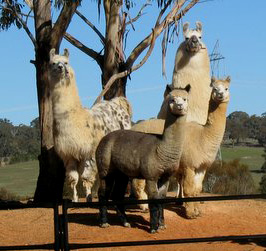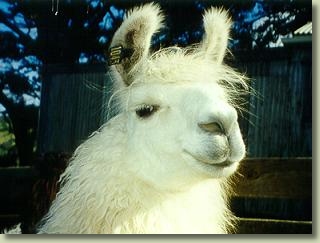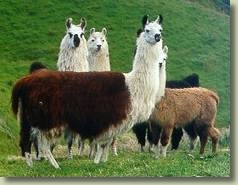General Appearance and Type
The llama is an athletic animal, tall and sturdily built with an appearance of strength and nobility. Its movements should be fluid and graceful, with both head and tail carried high. Its disposition is calm and it's nature curious.
It is a symmetrical, well balanced animal with neck length being proportionate to both back and leg length. Generally, a llama reaches maturity at about three years of age. It should be capable of carrying a load over long distances and when true to type, will exhibit the characteristics listed in this standard.
What is the difference between a llama and an alpaca?
 This question is asked by almost everyone who comes in contact with these beautiful animals. Hopefully the photo below will help to show the differences Llamas are big and strong! Note the beautiful long banana (curved) shaped ears on the llamas and the short pointed ones on the alpacas (the two short characters in the foreground)!
This question is asked by almost everyone who comes in contact with these beautiful animals. Hopefully the photo below will help to show the differences Llamas are big and strong! Note the beautiful long banana (curved) shaped ears on the llamas and the short pointed ones on the alpacas (the two short characters in the foreground)!
Llamas have a nice straight back line and a high tail set whereas alpacas have a rounded sloping rear end with a low tail set.
The Head
 The head, which is carried proudly and alertly, is long and lean, tapering slightly to the nose.
The head, which is carried proudly and alertly, is long and lean, tapering slightly to the nose.- The eyes are large, should be bright and clear, oval in shape and set widely apart. Both eyes should be the same colour. They may be black or brown.
- The nose is well defined with slightly flared nostrils.
- The upper lip is evenly divided into two long, prehensile sections.
- The ears, carried upright when alert, are long, slightly rounded at the tips and curve inwards. They are covered with short hair or may (in the case of heavily woolled llamas) be fringed with long hair.
- The jaws must fit well together and be even in length. Lower front teeth should press evenly against the hard pad of the upper jaw. Faults; Short or excessively tapered head, Overly protruding eyes, Short, pointed ears, Under or over shot jaw.
The Neck
The neck should be long, slender, continuing directly from the line of the backbone and blending smoothly into the shoulder. It should be carried in an upright position when moving and may be covered in short, medium or heavy dense fibre. Some llamas may have a mane down the back of the neck depending on the coat type. Faults; Neck "ewed" (dipping below front of withers), Neck length disproportionate to body size.
Forequarters
The chest should be fairly broad and reach deep to the elbows. Forechest should be well muscled. The wither should be well-set into the shoulders, well fleshed and relatively wide where the shoulders meet, forming a straight line with the back. Faults; Withers prominent, Shoulder blades loose, In or out at the elbows, Chest too broad or too narrow.
Body
The body should have good length without being overly long and should be deep through the girth with well sprung ribs. The back should be straight and strong with the topline level or rising slightly to the rear. Loins should be strong, broad and flat with a large deep back barrel. Faults Humped/roach-back or swayed back, Rounded or sloping croup, Shallow body, Slab-sidedness.
HindQuarters
Basically the rump should be flat and broad, with a good space between the pin-bones. The tail, although short in relation to the overall size of the animal, should still be long enough to cover the genital area and be completely covered with fibre. In profile, particularly when the animal is moving, the tail should be set, curved and carried high. Thighs should be broad, strong, well muscled and the height of the pin-bones should be equal to or slightly higher than that of the withers. Faults; Pin-bones lower than withers, Hindquarters weak and narrow, Tail too short, low set, crooked or poorly carried.
Legs and Feet
 When viewed from the front, forelegs should drop vertically from shoulder to fetlock and be straight, well boned and strong, with minimum inward deviation. Toes should point forward and pasterns should be strong and upright. Feet are well-formed with two forward pointing toe-nails, either dark or pale in colour. A calloused pad covers the sole of the foot.
When viewed from the front, forelegs should drop vertically from shoulder to fetlock and be straight, well boned and strong, with minimum inward deviation. Toes should point forward and pasterns should be strong and upright. Feet are well-formed with two forward pointing toe-nails, either dark or pale in colour. A calloused pad covers the sole of the foot.
The hind-legs, when viewed from the rear, should appear parallel and straight. In profile, the thighs have good width and the moderate angulation of the cannon bone (metatarsus) gives the animal a slightly sickle-hocked appearance. Faults; Lack of angulation or post-leggedness, Small feet, Fused toes, Base wide or base narrow, Bow legged or knock-kneed, Knuckled-over or excessively sloping pasterns, Carpal deviation (toed in or toed out), Cow-hocked or sickle hocked, Camped out or camped under behind.
Female Genitalia & Udder
The Vulva should be set almost vertical. The udder should have four teats and be well attached. Faults; Either more or less that four teats, Vulva horizontally positioned or any sign of hermaphrodism.
Testicles
A well attached scrotum should carry two equally sized testicles, approximately 3.5 - 7 cm in length, 2.3 - 3.5 cms in width and 3 - 4cms in depth at maturity. Faults: Small testes in mature male, Testes of unequal size, Ectopic testes.
Height and Weight
A mature llama, over three years old, will reach a minimum height of 100cms at the withers and weigh at least 100kgs.
Fleece Type & Distribution
Llamas fall into three fleece type categories ... short, medium and heavy woolled.
Colour
Llamas come in an almost limitless range of colours ... black, white, grey, cream, fawn, honey through to brown and red. Animals come in solid colours, roan, appaloosa, pied and any combination of the above.
Gait
The llama has three natural gaits ... walk, pace and gallop and it should move easily from one to the next. At the walk and pace, the animal has a tendency to "single track." At no time when galloping, are all four feet off the ground simultaneously. The llama does not trot naturally. It must be remembered this is primarily a pacing animal and this gait is best adapted to an animal which is not so broad-bodied as to inhibit the movement of the long forward moving limbs. Faults: Divergence of the feet, lameness, uneven length of stride, feet dragging, winging out, paddling, rope walking.
Temperent
The llama is a charismatic animal and appears to exude a sense of superiority. The llama is curious, generally calm, but aloof. The llamas temperament is in keeping with its all-purpose requirements. The llama is trustworthy around both the very young and old and should not be given to panic when undergoing normal handling and examination.
Footnote
In order to maintain the llama's breed identity, all distinguishing features should receive consideration, but those of a utilitarian nature, which related directly to performance or production, should of necessity, carry more weight than such points as colour, markings, or the shape of the head, face or ears.


